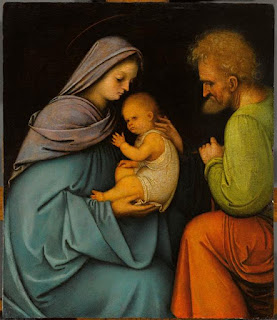According to the Italian Malaguzzi Valeri, he definitively identified the artist in 1912. The American expatriate Bernard Berenson gave himself credit for the attribution, dating the discovery to 1890.. Given his track record, I am inclined to doubt Berenson but the one they agreed on was that the identification of of the late 15th century Lombard painter took four hundred years. We may also consider that the esteemed art historian Adolfo Venturi sided with Berenson.
Moving between Milan and the Veneto, Agostini da Lodi was a bearer of Milanese style to Venice. His contemporaries prized the artist's work for its extravagance. but I like this Holy Family for its directness and simplicity. These qualities would have enhanced its power to make the Nativity vivid for n audience that mostly could not read and did not have direct personal access to Biblical stories.
Image: Giovanni Agostini da Lodi - The Holy Family - oil on wood pane, 16th century, Louvre, Museum.


6 comments:
lovely!
I always think that Bernard Berenson was a fun sort of art historian, even if he had to show a great deal of self confidence around the turn of the century. His books on Italian renaissance artists were go-to-books when I was at uni. I don't remember Agostini da Lodi, but you are right that at least in this painting, his presentation of the Holy Family was very simple. Just like an ordinary couple with their newborn.
They don't smile, these parents so attentive to the child. The characters stand out from the black background and wear plain clothes. I love these colors, the shawl of Mary in such soft tones. Thanks, Jane.
Hels, since either of us studied art history there has been much research showing )often in his own words) that Berenson played a loose game with truth when it suite him.
Tania, I, too, love the simplicity of this image. Portraying the three as some sort of visiting celebrities may have made wealthy patrons feel as though they had gotten their money's worth.
Jello, Peggy. Yes it is!
Post a Comment